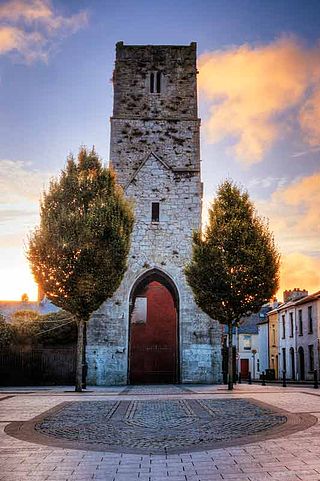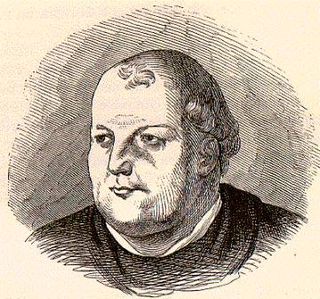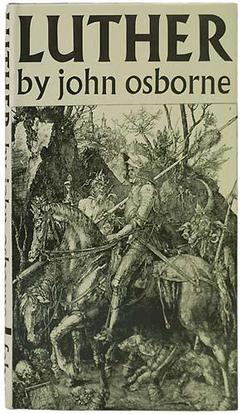
Augustinians are members of several religious orders that follow the Rule of Saint Augustine, written in about 400 AD by Augustine of Hippo. There are two distinct types of Augustinians in Catholic religious orders dating back to the 12th–13th centuries:

The Red Abbey in Cork, Ireland was a 14th-century Augustinian abbey which took its name from the reddish sandstone used in construction. Today all that remains of the structure is the central bell tower of the abbey church, which is one of the last remaining visible structures dating to the medieval walled town of Cork.

Fivizzano is a comune in the province of Massa and Carrara, Tuscany, central Italy.

Johann von Staupitz was a German Catholic priest and theologian, university preacher, and Vicar General of the Augustinian friars in Germany, who supervised Martin Luther during a critical period in his spiritual life. Martin Luther himself remarked, "If it had not been for Dr. Staupitz, I should have sunk in hell." Although he remained Catholic, died as a Benedictine monk and had repudiated the Reformation, he is commemorated on 8 November as a priest in the Calendar of Saints of the Lutheran Church–Missouri Synod.

Luther is a 1961 play by John Osborne depicting the life of Martin Luther, one of the foremost instigators of the Protestant Reformation. Albert Finney created the role of Luther, which he performed with the English Stage Company at the Theatre Royal, Nottingham, the Théâtre Sarah Bernhardt, Paris, the Holland Festival, the Royal Court Theatre, London, the Phoenix Theatre, London, and the St. James Theatre, New York.

The Monastery of the Holy Saviour at Lecceto in Tuscany, was the principal House of the order of the Hermit Friars of Saint Augustine in 1256, when Pope Alexander IV constituted the Augustinian order internationally. It was dedicated to Jesus as Saviour.

The Order of Saint Augustine, abbreviated OSA, is a mendicant religious order of the Catholic Church. It was founded in 1244 by bringing together several eremitical groups in the Tuscany region who were following the Rule of Saint Augustine, written by Saint Augustine of Hippo in the fifth century.

Clare Priory is a religious house in England, originally established in 1248 as the first house of the Augustinian Friars in England. It is situated on the banks of the River Stour, a short distance away from the medieval village of Clare, Suffolk. The friary was suppressed in 1538 and the property passed through many hands until it was again purchased by the Augustinian friars in 1953. Today the Priory offers modern retreat facilities for guests.

Pius Keller, OSA was an Augustinian friar, a teacher, and a leader who revitalized the Order of Saint Augustine in Germany.

James of Viterbo, born Giacomo Capocci, was an Italian Roman Catholic Augustinian friar and Scholastic theologian, who later became Archbishop of Naples.

St Thomas's Abbey is an Augustinian abbey and church located in Brno in the Czech Republic. The geneticist and abbot Gregor Mendel was its most famous religious leader to date, who between 1856 and 1863 conducted his experiments on pea plants in the monastery garden. His experiments brought forth two generalizations which later became known as Mendel's Laws of Inheritance.

Luther is a 2003 historical drama film dramatizing the life of Protestant Christian reformer Martin Luther. It is directed by Eric Till and stars Joseph Fiennes in the title role. Alfred Molina, Jonathan Firth, Claire Cox, Bruno Ganz, and Sir Peter Ustinov co-star. The film covers Luther's life from his becoming a friar in 1505, to his trial before the Diet of Augsburg in 1530. The American-German co-production was partially funded by Thrivent Financial for Lutherans, a Christian financial services company.

Hasserode Castle in the quarter of the same name in the town of Wernigerode am Harz was a medieval fortification whose site is near Hasserode station on the Harz Narrow Gauge Railways. Today there are no visible traces left of the castle.

Hasserode has been a quarter in the town of Wernigerode in the German state of Saxony-Anhalt since 1907.

The Lutherhaus is a writer's house museum in Lutherstadt Wittenberg, Germany. Originally built in 1504 as part of the University of Wittenberg, the building was the home of Martin Luther for most of his adult life and a significant location in the history of the Protestant Reformation. Luther was living here when he wrote his 95 Theses.
There are several abbeys in Germany with the name Himmelpforten :

The Mönchsbuche is an old beech tree in the Harz Mountains of Germany that has been designated as a natural monument due to its age and the stories surrounding it. It stands on a ridge near Hasserode in the borough of Wernigerode, on an old way between the abbeys of Himmelpforten and Ilsenburg and is reputedly where the monks used to stop and rest. In March 2011 the top of the old tree, that is over 100 years old, was removed in order to save it from breaking apart.

St. Augustine's Monastery in Erfurt, central Germany, is a former church and friary complex dating from the 13th century. The site is almost one hectare in size. It was built by Augustinian friars, an order of the Catholic Church. It is most well known as the former home of Martin Luther (1483–1546), the father of the Reformation, who lived there as a friar from 1505 until 1511.


















